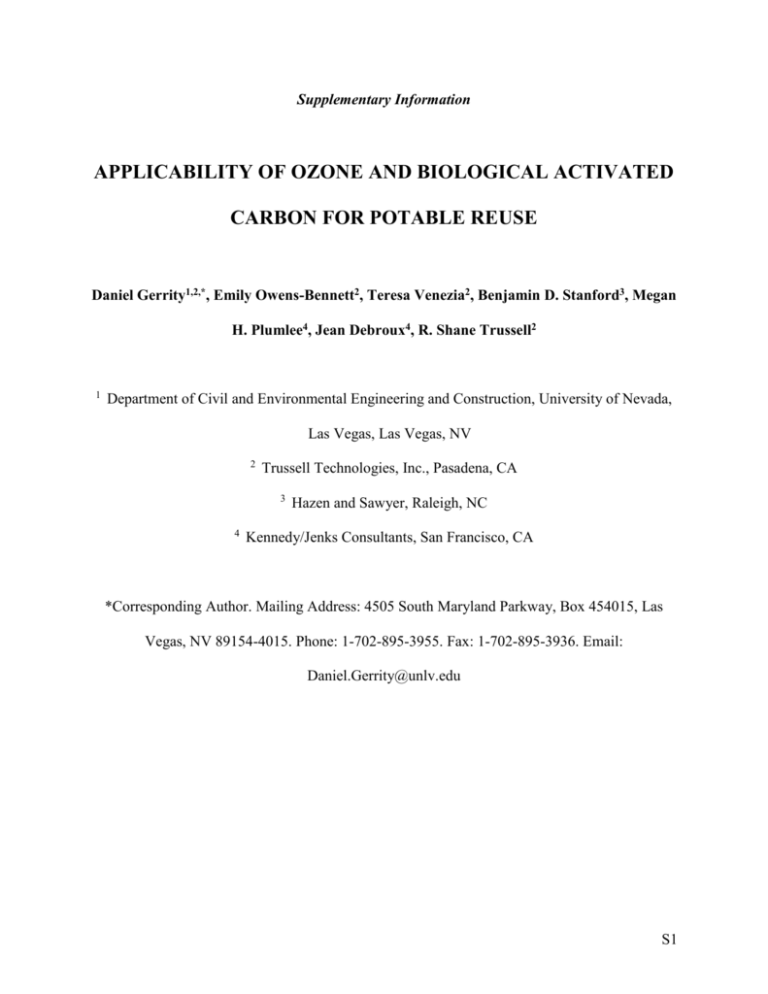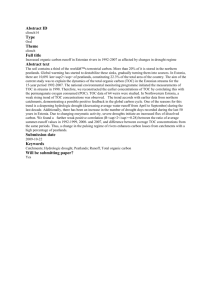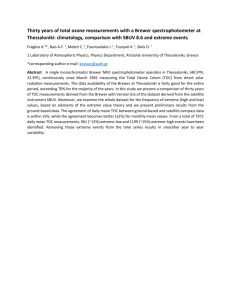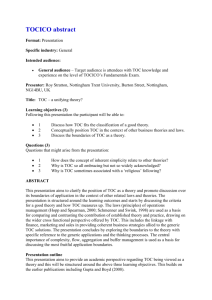Title of Manuscript
advertisement

Supplementary Information APPLICABILITY OF OZONE AND BIOLOGICAL ACTIVATED CARBON FOR POTABLE REUSE Daniel Gerrity1,2,*, Emily Owens-Bennett2, Teresa Venezia2, Benjamin D. Stanford3, Megan H. Plumlee4, Jean Debroux4, R. Shane Trussell2 1 Department of Civil and Environmental Engineering and Construction, University of Nevada, Las Vegas, Las Vegas, NV 2 Trussell Technologies, Inc., Pasadena, CA 3 4 Hazen and Sawyer, Raleigh, NC Kennedy/Jenks Consultants, San Francisco, CA *Corresponding Author. Mailing Address: 4505 South Maryland Parkway, Box 454015, Las Vegas, NV 89154-4015. Phone: 1-702-895-3955. Fax: 1-702-895-3936. Email: Daniel.Gerrity@unlv.edu S1 Text S1. Description of Bench-Scale Ozone Experiments Ozone doses were administered by transferring an aliquot of the ozone stock solution into 500-mL or 1-L amber glass bottles. It is important to note that the ozone stock solution was dissolved in distilled water so the ozone spike effectively diluted the target water matrix. Particularly for wastewaters with high TOC values, ozone efficacy is affected by the potentially large volume of ozone added to each sample, which dilutes all of the wastewater constituents. With the exception of the ozone demand and decay experiments, an iterative approach was used to calculate the highest ozone spiking volume (i.e., for an O3:TOC ratio of 1.5) for each wastewater since this condition had the greatest dilution effect. Regardless of the O3:TOC value, the volume of wastewater in each sample was held constant based on the difference between the total sample volume (e.g., 1 L) and the volume of ozone stock for the O3:TOC ratio of 1.5. For the lower O3:TOC ratios, less ozone stock was required so the samples were supplemented with distilled water to target final volumes of 500 mL or 1 L. The O3:TOC values, and inherently the ozone doses, were based on the final TOC value of each wastewater after accounting for the dilution effect. In calculating relative treatment levels (e.g., reduction in TOrC concentrations or UV254 absorbance), the ambient levels were also adjusted for this dilution effect. Nitrite was not detected in either wastewater matrix so it did not factor into the dosing calculations. Example dosing calculations are provided below for the chlorinated tertiary effluent; the calculations also illustrate how to account for nitrite and hydrogen peroxide, when applicable. Samples analyzed prior to the bench-scale experiments indicated that the initial TOC concentration in the chlorinated tertiary effluent was 8.20 mg-C/L, and the initial NO2concentration was <0.25 mg-N/L or <0.82 mg-NO2/L. Based on a measured ozone stock concentration of 80 mg/L, an iterative calculation was performed to determine the required ozone S2 spiking volume for an O3:TOC ratio of 1.5. The final ozonated sample contained 867 mL of wastewater and 133 mL of ozone stock, which diluted the TOC concentration to 7.11 mg-C/L. The remaining volumes are summarized in Table 1. The equations below were used to verify the dosing procedure. If nitrite had been present, it would have been necessary to modify the dosing calculation to account for this rapid reaction (Eq. S1). [S1] O3 + NO2- O2 + NO3- Since NO2 = 46 g/mole as NO2 and O3 = 48 g/mole, the reaction requires an approximate 1:1 mass ratio in order to satisfy the ozone demand caused by nitrite. Therefore, assuming standard mass-based ratios for O3:TOC and O3:NO2, Eq. S2 can be used to verify the ozone dose; Eq. S3 shows the actual values for an O3:TOC ratio of 1.5. [S2] O3 (mg/L) = O3:TOC x [Dil. TOC] (mg-C/L) + [Dil. NO2-] (mg-NO2/L) [S3] O3 (mg/L) = 1.5 x 7.11 mg-C/L + 0 mg-NO2/L = 10.7 mg/L Although it was not used in this study, H2O2 is sometimes added to the system to expedite the decomposition of ozone into hydroxyl radicals and reduce bromate formation; a simplified reaction is described in Eq. S4. [S4] H2O2 + 2O3 2•OH + 3O2 Since the molecular weights of H2O2 (34 g/mole) and O3 (48 g/mole) are different, H2O2 addition is often described on a molar basis, as opposed to the mass-based ratios for O3:TOC and O3:NO2. Based on the simplified stoichiometry above, molar H2O2:O3 ratios of 0.5 and 1.0 are often used. The molar ratio of 0.5 is based on balanced stoichiometry, while the molar ratio of 1.0 is used to provide excess H2O2 for competing reactions. Since the nitrite-associated ozone demand is theoretically unavailable for reaction with H2O2, that portion of the applied ozone dose is not S3 included. Eq. S5-S7 describe these calculations in general terms and for mass-based O3:TOC and molar H2O2:O3 ratios of 1.5 and 1.0, respectively, in the SJCWRP effluent. [S5] Modified O3 (mg/L) = O3:TOC x [Dil. TOC] (mg-C/L) [S6] H2O2 (mg/L) = Modified O3 (mg/L) x [S7] H2O2 (mg/L) = 1.5 x 7.11 mg/L x 1 mmole O3 48 mg O3 1 mmole O3 48 mg O3 x molar H2 O2 : O3 x 34 mg H O2 x 1.0 x 1 mmole H2 2 O2 34 mg H2 O2 1 mmole H2 O2 = 7.6 mg/L A similar procedure was used to calculate the volumes and doses for the SJCWRP secondary effluent, as summarized in Table S1. For the ozone demand and decay experiments, the wastewater volumes were held constant, but the final reaction volumes varied (Table S2). The corresponding ozone stock and diluted TOC concentrations are summarized in Table S3. Table S1. Experimental Volumes for the Ozone Oxidation Experiments Secondary Effluent Volumes 1 Tertiary Effluent Volumes 2 3 4 3 WW Distilled O3 O3 WW Distilled O3 5 O3 (mL) (mL) (mL) (mg/L) (mL) (mL) (mL) (mg/L) 0.25 8386 138 24 1.9 867 110 23 1.8 0.50 884 78 38 3.8 867 89 44 3.6 1.00 884 38 78 7.7 867 44 89 7.1 1.50 884 0 116 11.5 867 0 133 10.7 1 Secondary: Initial TOC = 8.65 mg-C/L, diluted TOC = 7.65 mg-C/L, NO2 < 0.25 mg-N/L 2 Tertiary: Initial TOC = 8.20 mg-C/L, diluted TOC = 7.11 mg-C/L, NO2 < 0.25 mg-N/L 3 WW = wastewater 4 O3 stock concentration during secondary experiments (except O3:TOC of 0.25) = 99 mg/L 5 O3 stock concentration during tertiary experiments = 80 mg/L 6 Erroneously used 80 mg/L ozone stock: O3:TOC = 0.26 and diluted TOC = 7.25 mg-C/L O3:TOC Table S2. Experimental Volumes for the Ozone Demand and Decay Experiments O3:TOC 0.26 0.53 1.10 1.72 Secondary Effluent Volumes WW Distilled O3 (mL) O3 (mL) (mL) (mg/L) 500 0 11 2.2 500 0 29 4.3 500 0 61 8.7 500 0 75 13.0 Tertiary Effluent Volumes WW Distilled O3 O3 (mL) (mL) (mL) (mg/L) 500 0 12 2.1 500 0 29 4.1 500 0 51 8.2 500 0 75 12.3 S4 Table S3. Ozone Stock and TOC Concentrations for the Ozone Demand and Decay Experiments O3:TOC 0.26 0.53 1.10 1.72 Secondary Effluent O3 Stock Diluted TOC (mg/L) (mg-C/L) 100 8.46 78 8.17 80 7.71 100 7.53 Tertiary Effluent O3 Stock TOC (mg/L) (mg-C/L) 88 8.01 76 7.76 88 7.44 94 7.13 Figure S1. Measured instantaneous ozone demand (IOD) as a function of O3:TOC ratio. Figure S2. First order ozone decay rate constant as a function of O3:TOC ratio. S5 Figure S3. Time required for complete ozone decay as a function of O3:TOC ratio. S6 Table S4. TOrC Concentrations (ng/L) Increasing Treatment1 Target Compound Ambient Chlorinated Tertiary Effluent Ambient Secondary Effluent Ozonated Secondary Effluent O3:TOC=0.262 Ozonated Secondary Effluent O3:TOC=0.502 Ozonated Secondary Effluent O3:TOC=1.002 Ozonated Secondary Effluent O3:TOC=1.502 1,7-Dimethylxanthine 2,4-D 4-nonylphenol 4-tert-octylphenol Acesulfame-K Acetaminophen Albuterol Amoxicillin Andorostenedione Atenolol Atrazine Azithromycin Bendroflumethiazide Bezafibrate Bisphenol A Bromacil Butalbital Butylparaben Caffeine Carbadox Carbamazepine Carisoprodol Chloramphenicol Chloridazon Chlorotoluron Cimetidine Clofibric Acid Cotinine Cyanazine DACT DEA DEET Dehydronifedipine DIA Diazepam Diclofenac Diuron Erythromycin Estradiol Estrone Ethinyl Estradiol Ethylparaben Flumeqine Fluoxetine Gemfibrozil Ibuprofen Iohexal Iopromide <5 300 860 8,400 18,000 7.5 6 < 20 <5 160 <5 N/A <5 11 < 10 <5 <5 <5 60 <5 290 140 < 10 <5 <5 <5 <5 46 <5 19 <5 46 240 <5 <5 30 46 180 <5 <5 <5 < 20 < 10 14 78 < 15 1,500 3,400 <5 <5 1,400 18,000 24,000 68 15 1,600 <5 450 <5 N/A <5 13 < 10 <5 <5 <5 210 <5 320 79 < 10 <5 <5 280 <5 49 <5 44 <5 46 270 <5 <5 74 48 270 <5 14 <5 < 20 < 10 35 350 < 15 2,500 3,000 <5 53 390 6,300 15,000 14 <5 220 <5 330 <5 N/A <5 7.7 < 10 <5 <5 <5 130 <5 65 51 < 10 <5 <5 19 <5 42 <5 14 <5 29 210 <5 <5 28 28 61 <5 <5 <5 < 20 < 10 25 <5 < 15 1,700 2,100 <5 6.1 250 < 50 12,000 10 <5 56 <5 200 <5 N/A <5 <5 < 10 <5 <5 <5 76 <5 16 58 < 10 <5 <5 <5 <5 46 <5 11 <5 25 220 <5 <5 18 20 19 <5 <5 <5 < 20 < 10 12 <5 < 15 1,600 1,800 <5 13 < 100 < 50 1,700 10 <5 < 20 <5 <5 <5 N/A <5 <5 < 10 <5 13 <5 <5 <5 <5 17 < 10 <5 <5 <5 <5 29 <5 13 <5 6.4 160 <5 <5 <5 <5 < 10 <5 <5 <5 < 20 < 10 < 10 <5 < 15 630 840 <5 8.7 < 100 < 50 160 6 <5 < 20 <5 <5 <5 N/A <5 <5 < 10 <5 <5 <5 15 <5 <5 10 < 10 <5 <5 <5 <5 24 <5 9.9 <5 2.8 120 <5 <5 <5 <5 < 10 <5 <5 <5 < 20 < 10 < 10 <5 < 15 470 680 S7 Increasing Treatment1 Target Compound Ambient Chlorinated Tertiary Effluent Ambient Secondary Effluent Ozonated Secondary Effluent O3:TOC=0.262 Ozonated Secondary Effluent O3:TOC=0.502 Ozonated Secondary Effluent O3:TOC=1.002 Ozonated Secondary Effluent O3:TOC=1.502 Isobutylparaben <5 <5 <5 <5 <5 <5 Isoproturon < 100 < 100 < 100 < 100 < 100 < 100 Ketoprofen 9.3 8.5 <5 <5 <5 <5 Ketorolac 9.1 13 <5 <5 <5 <5 Lidocaine 140 150 41 12 <5 <5 Lincomycin < 10 < 10 < 10 < 10 < 10 < 10 Linuron <5 <5 <5 <5 <5 <5 Lopressor 120 240 140 93 < 20 < 20 Meclofenamic Acid <5 <5 <5 <5 <5 <5 Meprobamate 170 190 160 140 74 51 Metazachlor <5 <5 <5 <5 <5 <5 Methylparaben < 20 < 20 < 20 < 20 < 20 < 20 Naproxen 100 64 28 42 < 10 < 10 Nifedipine < 20 < 20 < 20 < 20 < 20 < 20 Norethisterone <5 <5 <5 <5 <5 <5 Oxolinic Acid <5 <5 <5 <5 <5 <5 Pentoxifylline <5 <5 <5 <5 <5 <5 Phenazone <5 <5 <5 <5 <5 <5 Phenytoin 150 160 97 82 < 20 < 20 Primidone 120 440 250 220 55 19 Progesterone <5 <5 <5 <5 <5 <5 Propazine <5 <5 <5 <5 <5 <5 Propylparaben <5 <5 <5 <5 <5 <5 Quinoline <5 <5 <5 <5 <5 <5 Simazine 7.6 8.1 6 5.4 <5 <5 Sucralose 15,000 17,000 9,900 9,900 7,000 5,500 Sulfachloropyridazine <5 <5 <5 <5 <5 <5 Sulfadiazine <5 <5 <5 <5 <5 <5 Sulfadimethoxine <5 9.4 <5 <5 <5 <5 Sulfamerazine <5 <5 <5 <5 <5 <5 Sulfamethazine 5.1 5.8 <5 <5 <5 <5 Sulfamethizole <5 <5 <5 <5 <5 <5 Sulfamethoxazole 320 740 170 62 <5 <5 Sulfathiazole <5 <5 <5 <5 <5 <5 TCEP 140 110 100 93 100 100 TCPP 820 740 650 660 690 600 TDCPP 630 330 360 350 420 360 Testosterone <5 <5 <5 <5 <5 <5 Theobromine 120 250 82 68 <5 15 Theophylline < 10 31 18 23 19 11 Triclosan 12 63 16 < 10 < 10 < 10 Trimethoprim 39 84 16 <5 <5 <5 Warfarin <5 <5 <5 <5 <5 <5 1 Arrows point in both directions because the ambient secondary effluent is used as the baseline. The arrow to the left represents any potential reduction in concentration due to chlorination. The arrow to the right represents any potential reduction to due ozonation. 2 These are the actual concentrations reported by the contract laboratory. TOrC concentrations for the ozonated samples were not adjusted to account for dilution effect from ozone spike. However, the ambient values are the true concentrations for those matrices. The ambient values must be adjusted for any relative calculations. S8






